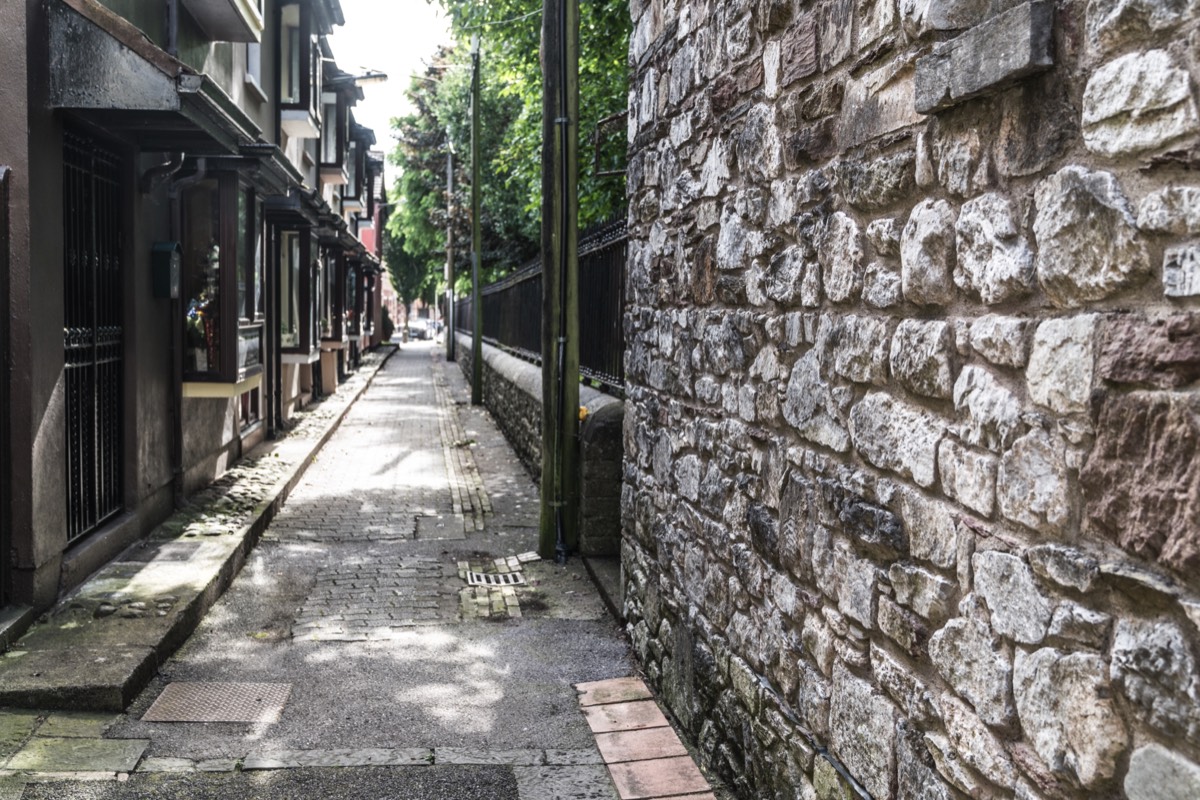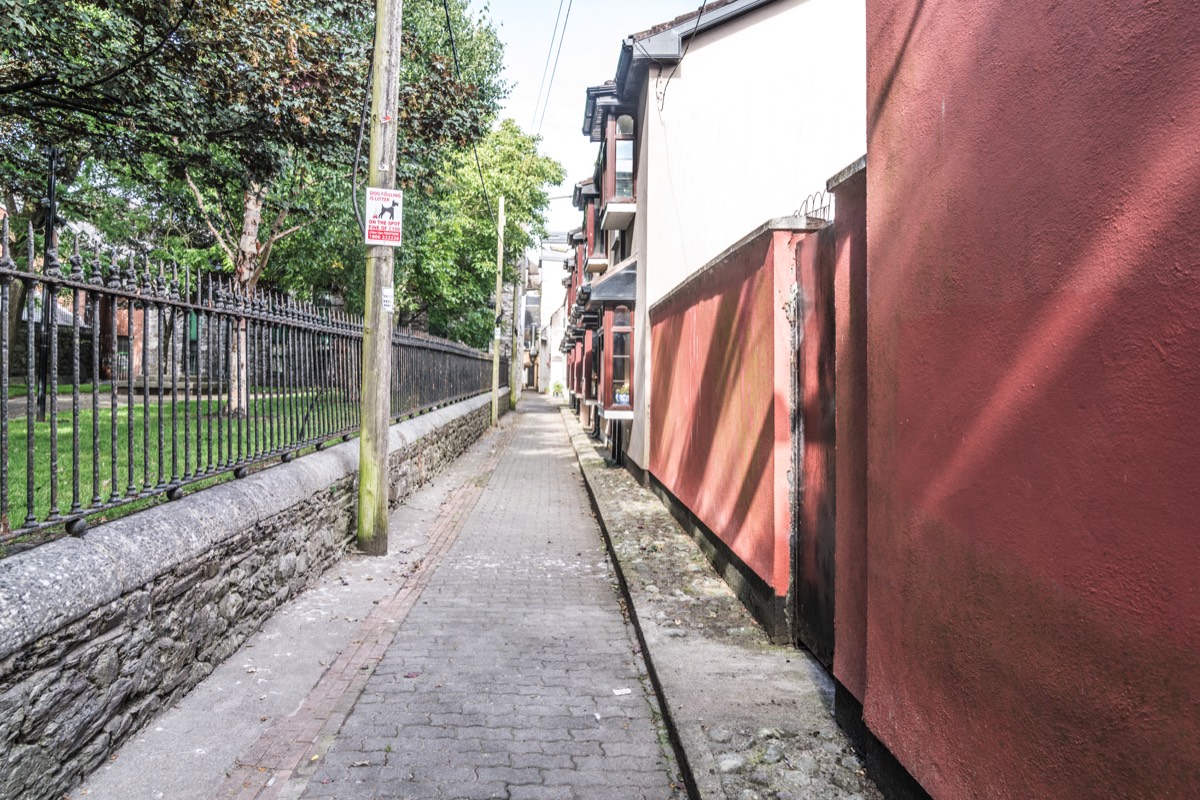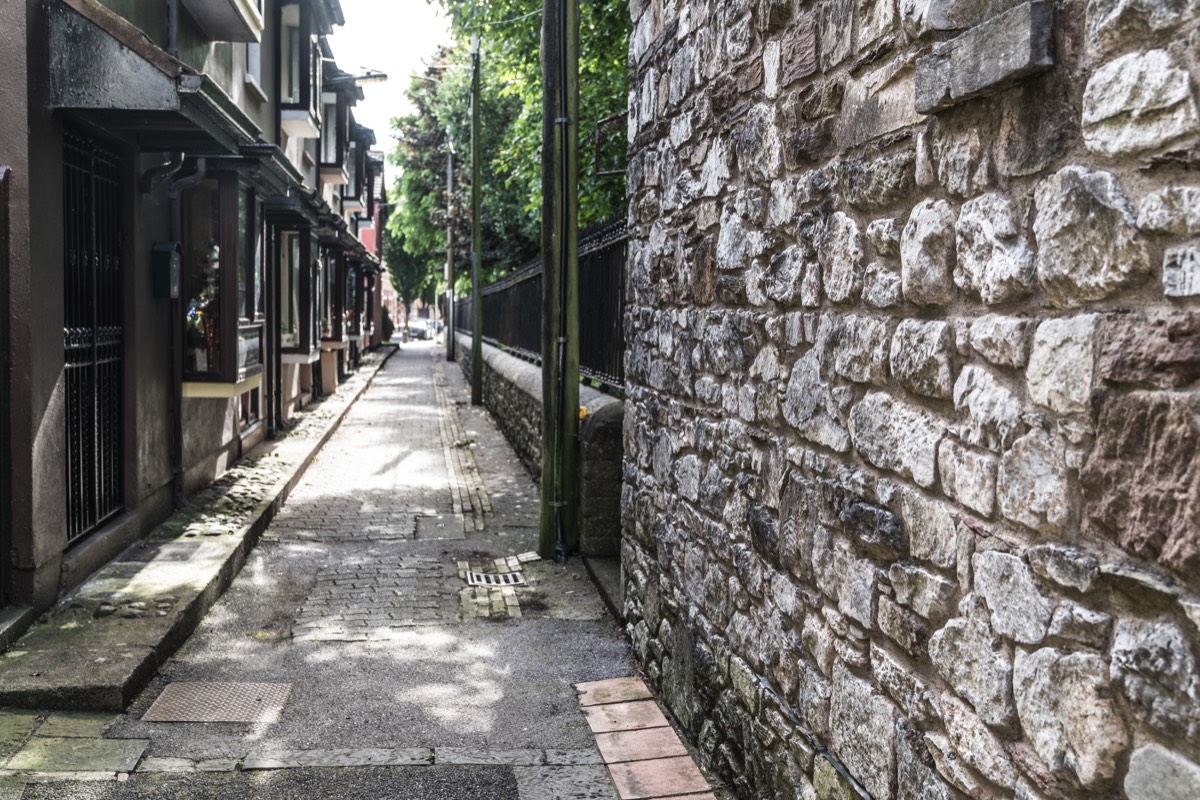NEAR ST. PETER'S PARK
A RENOVATED SAINT PETER’S LANE [BESIDE ST. PETER’S OLD CHURCHYARD]
This is Saint Peter’s Lane and it is off Grattan Street running beside St. Peter’s Park [originally St. Peter’s churchyard]. However it may now be known as St. Peter’s Church Lane or Saint Peter’s Avenue [according the the Ordnance Survey Map of the area]. I am assuming that the OSI is correct.
Grattan Street was originally known as Duncan Street while St Peter's Lane was also known as Peter's Street. According to Google Maps it is still known as Peter’s Street today.
There is a strange story associated with the churchyard: April 19 1753 “Francis Taylor was buried in Peter's churchyard, and the next morning was found sitting up in the grave, his cap and shroud tore to pieces, the coffin broke, one of his shoulders much mangled, one of his hands full of clay, and blood running from his eyes.” On the 19 September 1776 Francis Taylor was buried at St Peters so he lived for a further 23 years. It is up to you to decide if you believe this story.
In the late 19th century some of the worst slums in Cork were demolished by the Corporation. However the inhabitants were not rehoused by the corporation. They were forced to find new housing where they could in the city. The sites of slums were sold to the Improved Dwellings Company. The built 'model' dwellings with street names such as Prosperity Square and Industry Place. The new houses were too expensive for the poor and most went to skilled workers.
Cork's inner city slums were cleared by the municipal authority from the 1920s onwards, and their inhabitants were re-housed in housing estates on the periphery of the city. Many of these new suburbs have since suffered from social deprivation and high crime rates.
Cork's economy dipped in the late 20th century as the old manufacturing industries in Cork declined. The Ford car factory closed in 1984 as did the Dunlop tyre factory. Shipbuilding in Cork also came to an end in the 1980s. As a result of these closures unemployment was high in Cork in the 1980s.
However, in the 1990s new industries came to Cork. For instance, Marina Commercial Park was built on the site of the old Dunlop and Ford plants and Cork Airport Business Park first opened in 1999. Cork, like other cities in Ireland benefited somewhat from the Celtic Tiger economic boom, with growth in industries such as information technology, chemicals, brewing, distilling and food processing. The Port of Cork is also a busy and important port. Into the 21st century, tourism has grown in economic importance, and in 2005 Cork was named European Capital of Culture.
This is Saint Peter’s Lane and it is off Grattan Street running beside St. Peter’s Park [originally St. Peter’s churchyard]. However it may now be known as St. Peter’s Church Lane or Saint Peter’s Avenue [according the the Ordnance Survey Map of the area]. I am assuming that the OSI is correct.
Grattan Street was originally known as Duncan Street while St Peter's Lane was also known as Peter's Street. According to Google Maps it is still known as Peter’s Street today.
There is a strange story associated with the churchyard: April 19 1753 “Francis Taylor was buried in Peter's churchyard, and the next morning was found sitting up in the grave, his cap and shroud tore to pieces, the coffin broke, one of his shoulders much mangled, one of his hands full of clay, and blood running from his eyes.” On the 19 September 1776 Francis Taylor was buried at St Peters so he lived for a further 23 years. It is up to you to decide if you believe this story.
In the late 19th century some of the worst slums in Cork were demolished by the Corporation. However the inhabitants were not rehoused by the corporation. They were forced to find new housing where they could in the city. The sites of slums were sold to the Improved Dwellings Company. The built 'model' dwellings with street names such as Prosperity Square and Industry Place. The new houses were too expensive for the poor and most went to skilled workers.
Cork's inner city slums were cleared by the municipal authority from the 1920s onwards, and their inhabitants were re-housed in housing estates on the periphery of the city. Many of these new suburbs have since suffered from social deprivation and high crime rates.
Cork's economy dipped in the late 20th century as the old manufacturing industries in Cork declined. The Ford car factory closed in 1984 as did the Dunlop tyre factory. Shipbuilding in Cork also came to an end in the 1980s. As a result of these closures unemployment was high in Cork in the 1980s.
However, in the 1990s new industries came to Cork. For instance, Marina Commercial Park was built on the site of the old Dunlop and Ford plants and Cork Airport Business Park first opened in 1999. Cork, like other cities in Ireland benefited somewhat from the Celtic Tiger economic boom, with growth in industries such as information technology, chemicals, brewing, distilling and food processing. The Port of Cork is also a busy and important port. Into the 21st century, tourism has grown in economic importance, and in 2005 Cork was named European Capital of Culture.



THE PHOTO DIARY IS NOT LIMITED TO CORK AS I ONLY VISIT THE CITY ONCE EVERY YEAR AND 2020 MAY BE AN EXCEPTION. I AM BASED IN DUBLIN BUT DURING THE SUMMER MONTHS I VISIT BELFAST, LIMERICK, GALWAY, KILKENNY AND WATERFORD AND USUALLY DEVOTE A WEEK TO PHOTOGRAPHING EACH OF THE CITIES IN QUESTION
You will find links to buy products from Amazon, Google and other partners. If you click on these links, you’ll find that the URL includes a small extra piece of text which identifies that the click came from my websites. This text is an affiliate code, and it means that I get a small percentage of the money you spend if you choose to buy that product, or, in some cases, other products from the site soon after. These affiliate links help pay the costs of producing my websites and ensure that the content is free to you.